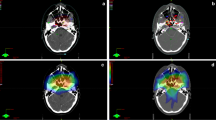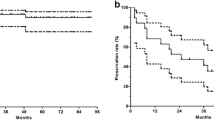Abstract
Background
Cochlea sparing can reduce late ototoxicity in head and neck cancer patients treated with cisplatin-based radiochemotherapy. In this situation, a mean cochlear dose (MCD) constraint of 10 Gy has been suggested by others based on the dose–effect relationship of clinical data. We aimed to investigate whether this is feasible for primary and postoperative radiochemotherapy in locoregionally advanced tumors without compromising target coverage.
Patients and methods
Ten patients treated with definitive and ten patients treated with adjuvant intensity-modulated radiotherapy (IMRT) and concurrent chemotherapy were investigated. The cochleae and a planning risk volume (PRV) with a 3 mm margin were newly delineated, whereas target volumes and other organs at risk were not changed. The initial plan was recalculated with a constraint of 10 Gy (MCD) on the low-risk side. The quality of the resulting plan was evaluated using the difference in the equivalent uniform dose (EUD).
Results
A unilateral MCD of below 10 Gy could be achieved in every patient. The mean MCD was 6.8 Gy in the adjuvant cohort and 7.6 Gy in the definitive cohort, while the non-spared side showed a mean MCD of 18.7 and 30.3 Gy, respectively. The mean PRV doses were 7.8 and 8.4 Gy for the spared side and 18.5 and 29.8 Gy for the non-spared side, respectively. The mean EUD values of the initial and recalculated plans were identical. Target volume was not compromised.
Conclusion
Unilateral cochlea sparing with an MCD of less than 10 Gy is feasible without compromising the target volume or dose coverage in locoregionally advanced head and neck cancer patients treated with IMRT. A prospective evaluation of the clinical benefit of this approach as well as further investigation of the dose–response relationship for future treatment modification appears promising.
Zusammenfassung
Zielsetzung
Eine Schonung der Cochlea kann die Toxizität bei Patienten mit Kopf-Hals-Tumoren, die mit einer cisplatinbasierten Radiochemotherapie behandelt werden, senken. Eine prospektive klinische Studie errechnete eine mittlere cochleäre Dosis (MCD) von <10 Gy, die in der kombinierten Therapie maximal appliziert werden darf. Wir untersuchen, ob dies sowohl bei primär radiochemotherapierten als auch bei postoperativ radiochemotherapierten Kopf-Hals-Tumorpatienten möglich ist, ohne dass es zu Unterdosierungen im Zielgebiet kommt.
Patienten und Methoden
Bei 10 Patienten, die eine definitive Radiochemotherapie, und bei 10 Patienten, die eine adjuvante intensitätsmodulierte Radiotherapie (IMRT) und eine gleichzeitige Chemotherapie erhielten, wurden die Bestrahlungspläne unter der Prämisse einer einseitigen MCD <10 Gy neu berechnet. Hierfür wurde die Cochlea an sich sowie mit einem 3‑mm-Saum („planning risk volume“, PRV) neu skizziert; andere Risikoorgane und das Zielvolumen wurden nicht verändert. Die Qualität der resultierenden Bestrahlungspläne wurde nach dem Konzept der „equivalent uniform dose“ (EUD) evaluiert.
Ergebnisse
Eine einseitige MCD <10 Gy wurde in allen Fällen erzielt. Die MCD lag bei 6,8 Gy in der adjuvant therapierten und bei 7,6 Gy in der definitiven Kohorte. Die MCD der nichtgeschonten Cochleae wies 18,7 Gy bzw. 30,3 Gy auf. Die mittlere PVR-Dosis betrug 7,8 Gy bzw. 8,4 Gy der geschonten Cochleae und 18,5 Gy bzw. 29,8 Gy der Gegenseite. Die mittlere EUD der neu berechneten und der ursprünglichen Pläne waren identisch.
Schlussfolgerung
Eine einseitige Cochleaschonung mit einer MCD <10 Gy ist mit der IMRT möglich, ohne das Zielvolumen in fortgeschrittenen Kopf-Hals-Tumorpatienten zu kompromittieren. Eine prospektive Studie, die die Dosis-Wirkungs-Beziehung und den klinischen Benefit dieses Ansatzes näher untersucht, scheint vielversprechend.


Similar content being viewed by others
References
Adunka OF, Buchman CA (2007) Cochlear implantation in the irradiated temporal bone. J Laryngol Otol 121(01):83–86. https://doi.org/10.1017/S0022215106002180
Bhandare N, Antonelli P, Morris C, Malayapa R, Mendenhall W (2007) Ototoxicity after radiotherapy for head and neck tumors. Int J Radiat Oncol Biol Phys 67(2):469–479. https://doi.org/10.1016/J.IJROBP.2006.09.017
Bhandare N, Jackson A, Eisbruch A, Pan CC, Flickinger JC, Antonelli P, Mendenhall WM (2010) Radiation therapy and hearing loss. Int J Radiat Oncol Biol Phys 76(3 Suppl). https://doi.org/10.1016/j.ijrobp.2009.04.096
Bhandare N, Mendenhall WM, Antonelli PJ (2009a) Radiation effects on the auditory and vestibular systems. Otolaryngol Clin North Am. https://doi.org/10.1016/j.otc.2009.04.002
Bhandare N, Mendenhall WM, Antonelli PJ (2009b) Radiation effects on the auditory and vestibular systems. Otolaryngol Clin North Am. https://doi.org/10.1016/j.otc.2009.04.002
Blanchard P, Baujat P, Holostenco V, Bourredjem A, Baey C, Bourhis J, Pignon J (2011) Meta-analysis of chemotherapy in head and neck cancer (MACH-NC): A comprehensive analysis by tumour site. Radiother Oncol 100(1):33–40. https://doi.org/10.1016/J.RADONC.2011.05.036
Brouwer CL, Steenbakkers RJHM, Bourhis J, Budach W, Grau C, Grégoire V et al (2015) CT-based delineation of organs at risk in the head and neck region: DAHANCA, EORTC, GORTEC, HKNPCSG, NCIC CTG, NCRI, NRG Oncology and TROG consensus guidelines. Radiother Oncol 117:83–90. https://doi.org/10.1016/j.radonc.2015.07.041
Cohen SM, Turley R (2009) Coprevalence and impact of dysphonia and hearing loss in the elderly. Laryngoscope 119(9):1870–1873. https://doi.org/10.1002/lary.20590
Das IJ, Andersen A, Chen ZJ, Dimofte A, Glatstein E, Hoisak J et al (2017) State of dose prescription and compliance to international standard (ICRU-83) in intensity modulated radiation therapy among academic institutions. Pract Radiat Oncol 7(2):e145–e155. https://doi.org/10.1016/J.PRRO.2016.11.003
Eisbruch A (2009) Radiotherapy: IMRT reduces xerostomia and potentially improves QoL. Nat Rev Clin Oncol 6(10):567–568. https://doi.org/10.1038/nrclinonc.2009.143
Fiorino C, Dell’Oca I, Pierelli A, Broggi S, Cattaneo GM, Chiara A et al (2007) Simultaneous Integrated Boost (SIB) for nasopharynx cancer with helical tomotherapy. Strahlenther Onkol 183(9):497–505. https://doi.org/10.1007/s00066-007-1698-x
Gabriele P, Orecchia R, Magnano M, Albera R, Sannazzari G (1992) Vestibular apparatus disorders after external radiation therapy for head and neck cancers. Radiother Oncol 25(1):25–30. https://doi.org/10.1016/0167-8140(92)90191-V
Genovesi D, Perrotti F, Trignani M, Di Pilla A, Vinciguerra A, Augurio A et al (2015) Delineating brachial plexus, cochlea, pharyngeal constrictor muscles and optic chiasm in head and neck radiotherapy: a CT-based model atlas. Radiol Med 120:352–360. https://doi.org/10.1007/s11547-014-0448-2
Hawkins P, Lee J, Mao Y, Li P, Green M, Worden F et al (2017) Sparing all salivary glands with IMRT for head and neck cancer: Longitudinal study of patient-reported xerostomia and head-and-neck quality of life. Radiother Oncol. https://doi.org/10.1016/J.RADONC.2017.08.002
Hitchcock YJ, Tward JD, Szabo A, Bentz BG, Shrieve DC (2009) Relative contributions of radiation and cisplatin-based chemotherapy to sensorineural hearing loss in head-and-neck cancer patients. Int J Radiat Oncol Biol Phys 73(3):779–788. https://doi.org/10.1016/j.ijrobp.2008.05.040
Huang E, Teh BS, Strother DR, Davis QG, Chiu JK, Lu HH, Carpenter LS, Mai WY, Chintagumpala MM, South M, Grant WH 3rd, Butler EB, Woo SY (2002) Intensity-modulated radiation therapy for pediatric medulloblastoma: early report on the reduction of ototoxicity. Int J Radiat Oncol Biol Phys 52(3):599-605
Jereczek-Fossa BA, Zarowski A, Milani F, Orecchia R (2003) Radiotherapy-induced ear toxicity. Cancer Treat Rev. https://doi.org/10.1016/S0305-7372(03)00066-5
Johannesen TB, Rasmussen K, Winther FØ, Halvorsen U, Lote K (2002) Late radiation effects on hearing, vestibular function, and taste in brain tumor patients. Int J Radiat Oncol Biol Phys 53:86–90
Karasawa T, Steyger PS (2016) An integrated view of cisplatin-induced nephrotoxicity and ototoxicity. Toxicol Lett 237(3):219–227. https://doi.org/10.1016/j.toxlet.2015.06.012.An
Landier W (2016) Ototoxicity and cancer therapy. Cancer. https://doi.org/10.1002/cncr.29779
Low W‑K, Gopal K, Goh LK, Fong KW (2006) Cochlear implantation in postirradiated ears: outcomes and challenges. Laryngoscope 116(7):1258–1262. https://doi.org/10.1097/01.mlg.0000225935.80559.11
Low W‑K, Tan MG, Chua AW, Sun L, Wang D‑Y (2009) 12th Yahya cohen memorial lecture—the cellular and molecular basis of radiation-induced sensori-neural hearing loss. Ann Acad Med Singapore 38(1):91–94
Low WK, Burgess R, Fong KW, Wang DY (2005) Effect of radiotherapy on retro-cochlear auditory pathways. Laryngoscope 115(10):1823–1826. https://doi.org/10.1097/01.mlg.0000175061.59315.58
Monzani D, Galeazzi GM, Genovese E, Marrara A, Martini A (2008) Psychological profile and social behaviour of working adults with mild or moderate hearing loss. Acta Otorhinolaryngol Italica 28(2):61–66 (Retrieved from http://www.ncbi.nlm.nih.gov/pubmed/18669069)
Mujica-Mota M, Waissbluth S, Daniel SJ (2014) Characteristics of radiation-induced sensorineural hearing loss in head and neck cancer: a systematic review. Head Neck 36(10):1391. https://doi.org/10.1002/HED
Nguyen NP, Ceizyk M, Vinh-Hung V, Sroka T, Jang S, Khan R et al (2012) Feasibility of tomotherapy to reduce cochlea radiation dose in patients with locally advanced nasopharyngeal cancer. Tumori J 98(6):709–714. https://doi.org/10.1700/1217.13493
Nguyen N, Smith-Raymond L, Vinh-Hun V, Sloan D, Davis R, Vosc P et al (2011) Feasibility of tomotherapy to spare the cochlea from excessive radiation in head and neck cancer. Oral Oncol 47(5):414–419. https://doi.org/10.1016/J.ORALONCOLOGY.2011.03.011
Pacholke HD, Amdur RJ, Schmalfuss IM, Louis D, Mendenhall WM (2005) Contouring the middle and inner ear on radiotherapy planning scans. Am J Clin Oncol 28:143–147. https://doi.org/10.1097/01.coc.0000143847.57027.16
Pan CC, Eisbruch A, Lee JS, Snorrason RM, Ten Haken RK, Kileny PR (2005) Prospective study of inner ear radiation dose and hearing loss in head-and-neck cancer patients. Int J Radiat Oncol Biol Phys. https://doi.org/10.1016/j.ijrobp.2004.08.019
Peng G, Wang T, Yang K, Zhang S, Zhang T, Li Q et al (2012) A prospective, randomized study comparing outcomes and toxicities of intensity-modulated radiotherapy vs. conventional two-dimensional radiotherapy for the treatment of nasopharyngeal carcinoma. Radiother Oncol 104(3):286–293. https://doi.org/10.1016/J.RADONC.2012.08.013
Pignon J‑P, le Maître A, Maillard E, Bourhis J (2009) Meta-analysis of chemotherapy in head and neck cancer (MACH-NC): An update on 93 randomised trials and 17,346 patients. Radiother Oncol 92(1):4–14. https://doi.org/10.1016/J.RADONC.2009.04.014
Scobioala S, Parfitt R, Ebrahimi F, Matulat P, Zehnhoff-Dinnesen A, Eich H (2017) Impact of radiation technique, fraction dose and total cisplatin dose on hearing: Retrospective analysis of 29 medulloblastoma patients. Strahlenther Onkol 193(1):96–S97. https://doi.org/10.1007/s00066-017-1137-6
Scoccianti S, Detti B, Gadda D, Greto D, Furfaro I, Meacci F et al (2015) Organs at risk in the brain and their dose-constraints in adults and in children: A radiation oncologist’s guide for delineation in everyday practice. Radiother Oncol 114:230–238. https://doi.org/10.1016/j.radonc.2015.01.016
Strojan P, Hutcheson KA, Eisbruch A, Beitler JJ, Langendijk JA, Lee AWM et al (2017) Complications of treatment treatment of late sequelae after radiotherapy for head and neck cancer. Cancer Treat Rev 59:79–92. https://doi.org/10.1016/j.ctrv.2017.07.003
Sun Y, Yu XL, Luo W, Lee AWM, Wee JTS, Lee N et al (2014) Recommendation for a contouring method and atlas of organs at risk in nasopharyngeal carcinoma patients receiving intensity-modulated radiotherapy. Radiother Oncol 110:390–397. https://doi.org/10.1016/j.radonc.2013.10.035
Theunissen EAR, Bosma SCJ, Zuur CL, Spijker R, van der Baan S, Dreschler WA et al (2014) Sensorineural hearing loss in patients with head and neck cancer after chemoradiotherapy and radiotherapy: A systematic review of the literature. Head Neck 36(10):1391. https://doi.org/10.1002/HED
Theunissen EAR, Dreschler WA, Latenstein MN, Rasch CRN, van der Baan S, de Boer JP et al (2014) A new grading system for ototoxicity in adults. Ann Otol Rhinol Laryngol 123(10):711–718. https://doi.org/10.1177/0003489414534010
Theunissen E, Zuur CL, Lopez Yurda M, Van Der BS, Kornman AF, De Boer PJ et al (2014) Cochlea sparing effects of intensity modulated radiation therapy in head and neck cancers patients: a long-term follow-up study. J Otolaryngol Head Neck Surg 43. https://doi.org/10.1186/s40463-014-0030-x
Van Der Laan HP, Bijl HP, Steenbakkers RJHM, Van Der Schaaf A, Chouvalova O, Vemer-Van Den Hoek JGM et al (2015) Prediction of dysphagia acute symptoms during the course of head and neck radiotherapy or chemoradiation are strong predictors of late dysphagia. Radiother Oncol 115:56–62. https://doi.org/10.1016/j.radonc.2015.01.019
Vergeer MR, Doornaert PAH, Rietveld DHF, Leemans CR, Slotman BJ, Langendijk JA (2009) Intensity-modulated radiotherapy reduces radiation-induced morbidity and improves health-related quality of life: results of a nonrandomized prospective study using a standardized follow-up program. Int J Radiat Oncol Biol Phys 74(1):1–8. https://doi.org/10.1016/j.ijrobp.2008.07.059
Wu Y, Hu W‑H, Xia Y‑F, Ma J, Liu M‑Z, Cui N‑J (2007) Quality of life of nasopharyngeal carcinoma survivors in Mainland China. Qual Life Res 16(1):65–74. https://doi.org/10.1007/s11136-006-9113-0
Zuur CL, Simis YJ, Lamers EA, Hart AA, Dreschler WA, Balm AJ, Rasch CR (2009) Risk factors for hearing loss in patients treated with intensity-modulated radiotherapy for head-and-neck tumors. Int J Radiat Oncol Biol Phys 74(2):490–496. https://doi.org/10.1016/j.ijrobp.2008.08.011
Theunissen EA, Zuur CL, Jozwiak K, Lopez-Yurda M, Hauptmann M, Rasch CR, van der Baan S, de Boer JP, Dreschler WA, Balm AJ (2015) Prediction of hearing loss due to cisplatin chemoradiotherapy. JAMA Otolaryngol Head Neck Surg 141(9):810–815
Lange J (2013) Klinische Anatomie des Ohres. Springer, Wien
Author information
Authors and Affiliations
Corresponding author
Ethics declarations
Conflict of interest
L.H. Braun, K. Braun, B. Frey, S.M. Wolpert, H. Löwenheim, D. Zips, and S. Welz declare that they have no competing interests.
Rights and permissions
About this article
Cite this article
Braun, L.H., Braun, K., Frey, B. et al. Unilateral cochlea sparing in locoregionally advanced head and neck cancer: a planning study. Strahlenther Onkol 194, 1124–1131 (2018). https://doi.org/10.1007/s00066-018-1344-9
Received:
Accepted:
Published:
Issue Date:
DOI: https://doi.org/10.1007/s00066-018-1344-9




